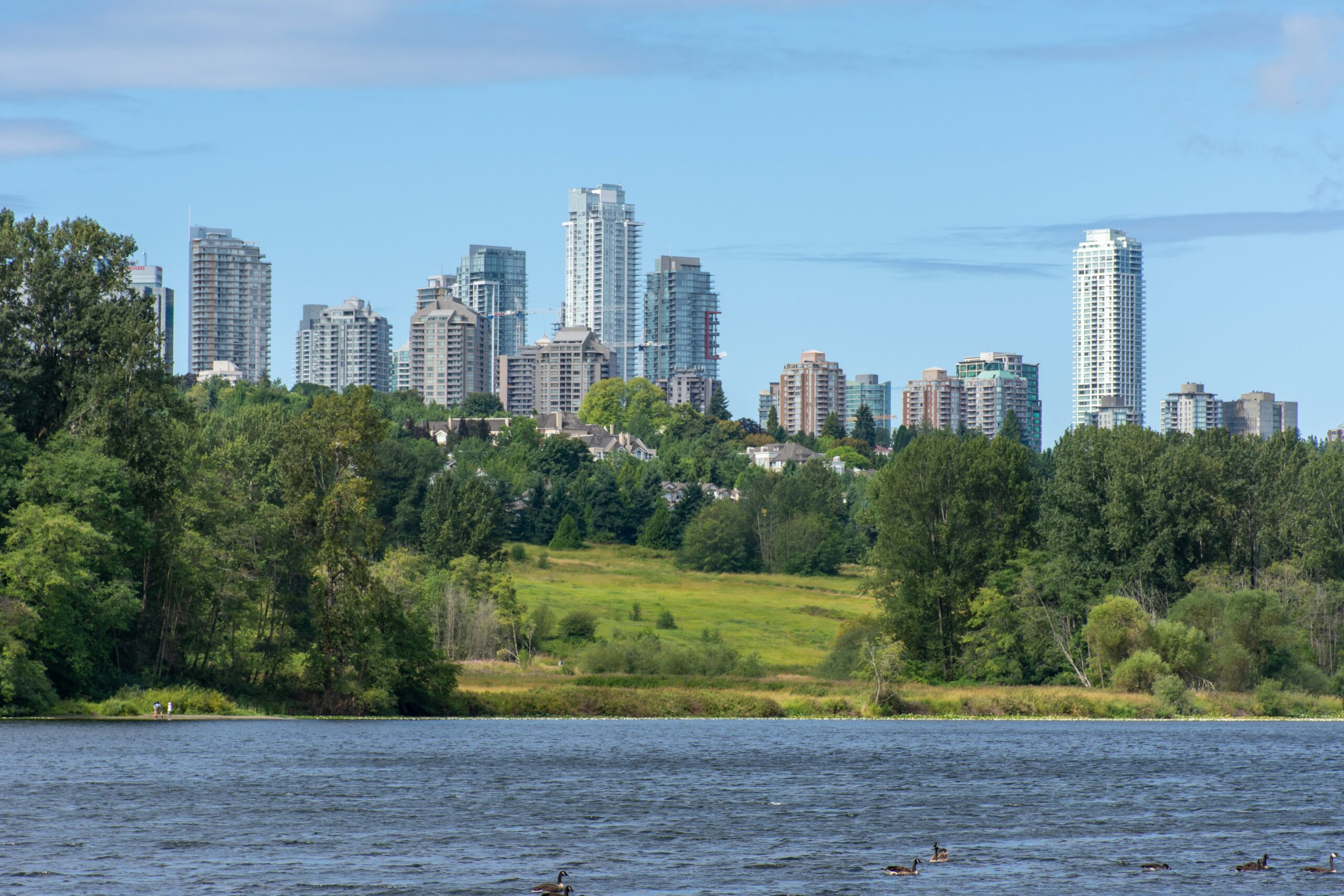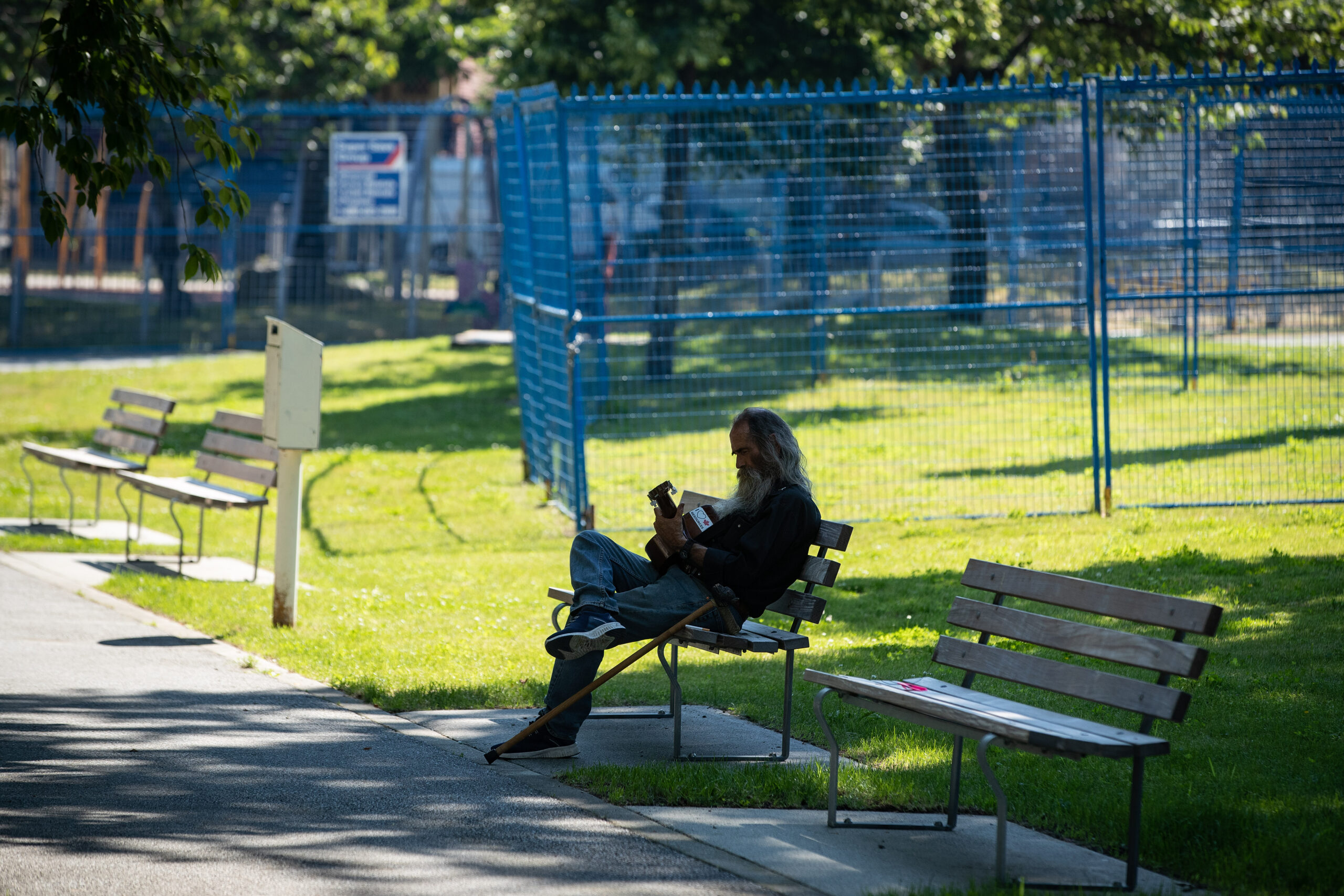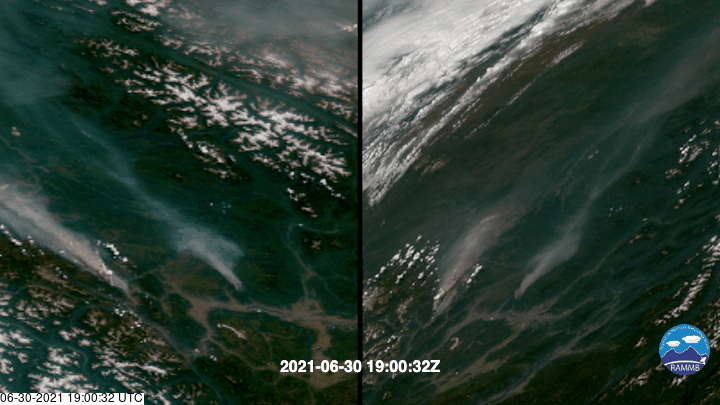
Celebrating 7 years of The Narwhal — and gearing up for the next 7
Between a fresh take on engagement and our new life on video, our team is...
Meteorologists call it an “Omega block.”
As the Arctic warms in the late spring and summer the temperature difference between the equator and the north pole shrinks, explained Armel Castellan, a warning preparedness meteorologist with Environment and Climate Change Canada.
When that happens the jet stream, a band of strong wind in the upper atmosphere, gets weaker and slower and wavier.
In late June, the peak, or ridge, of one of those waves stalled over British Columbia — in the shape of the Greek letter omega — creating a high-pressure dome that trapped hot air beneath it and blocked the oncoming jet stream from pushing the weather system on.
It brought with it a heat so extreme that hundreds of people died. In Lytton, where temperatures exceeded 49 C, the conditions set the stage for a catastrophic fire that engulfed the village. And, since then, wildfires have forced thousands more people across the Interior to flee their homes for safety.
The timing was critical, Castellan said. The heat dome settled over B.C. close to the summer solstice, meaning the days are long and the sun reaches its highest point in the sky, its powerful rays baking the surface of the Earth.
While the record-breaking heat wave was estimated to be a rare, 1 in 1,000-year event in today’s climate, it “was virtually impossible without human-caused climate change,” according to a rapid analysis by a group of scientists with the World Weather Attribution initiative.
But in a world that’s 2 C warmer than the latter half of the 19th century — 0.8 degrees warmer than today — such a heat wave could be much more common, occurring roughly every five to 10 years, the scientists found.
Inside Jennifer Baumbusch’s North Burnaby home, temperatures reached 37 C. Outside was even hotter.
“It was like nothing, I don’t think, that I had physically ever experienced before,” Baumbusch, an associate professor at the University of British Columbia’s School of Nursing, told The Narwhal.
“I was just sitting in my house drinking water and panting, just soaked in sweat,” she said. “There was no escape. None.”
Baumbusch, whose research has focused on long-term and seniors care, is currently working on a study that involves following families of people who have dementia and live in the community.
“They were just hugely impacted by that heat dome,” said Baumbusch, who is in regular contact with the families.

Before the heat wave hit, one of the people with dementia in her study was able to live at home with support from two family caregivers.
But on one of the hottest days, their main caregiver, who was experiencing chest pains, called 911 more than once over the course of one or two hours, Baumbusch said.
By the time the ambulance arrived, the caregiver had passed away and the person with dementia, suffering from heat exhaustion, was taken to hospital, their life forever changed.
“They were very disoriented and dehydrated,” Baumbusch said.
Upon release from hospital, they will most likely be transferred to a care home, she said. After suffering the loss of their main caregiver, the family no longer has the capacity to care for their loved one at home.
Seniors were among the hardest hit by the heat wave.
At least 569 people died from extreme heat between June 20 and July 29, according to the BC Coroners Service.
Almost 80 per cent of the people who died were 65 or older, 40 per cent were in their eighties and nineties and two people who died from extreme heat were under the age of 40, the service said.
“We’re at a crisis point and we need to take action,” Baumbusch said. “We need strong government action on this.”
The heat wave clearly demonstrated how extreme temperatures affect people living in the same city differently, said Gabrielle Peters, a member of the Vancouver City Planning Commission, a volunteer citizen advisory body.
When she saw posts online that Oppenheimer Park in Vancouver’s Downtown Eastside had remained closed to the public despite being one of the few green, shady spaces in that part of the city she was furious.
“It enraged and it pained me,” Peters said, to have a key park fenced off in one of the hotter parts of the city.
While people were eventually allowed access to most of the park, the situation prompted Peters and her fellow commissioner Amina Yasin to write a nine-page memorandum to the mayor, city council and the Vancouver Board of Parks and Recreation. In it, the planning commission recommended numerous short and long-term actions to help prepare the city for the next extreme heat event.

Among its recommendations, the planning commission asked that all parks, beaches, pools and public washrooms be kept open 24 hours a day during extremely hot weather; that tree planting efforts focus on “low-income and racialized neighbourhoods suffering from the urban heat island effect,” and that air purifiers be provided to low-income residents, particularly seniors and people with disabilities who are at higher risk from poor air quality.
While 24-hour cooling centres offer a vital respite from the heat for some, they may not be a feasible option for others, including seniors and people with disabilities, Peters noted.
“I’m a manual wheelchair user, and I’d have to wheel there while I’m short of breath in a situation where my body is collapsing and knowing full well that exertion is going to rapidly speed up that process,” said Peters, who has a neuromuscular condition and severe asthma.
The heat wave only underscored the importance of air conditioning and air purifiers for her health.
As she was working on the planning commission memo, she said she felt herself develop a headache, grow weaker and nauseous.
“Before I knew it, I was in a state where I haven’t been very often where you’re really struggling to think,” she said.
“Every time that we get now a warning that a heat wave’s coming, I feel the anxiety,” she said. “I was always aware that heat could kill me, but now I’m aware of it on a more cellular level.”
When it comes to mitigation measures, Peters said it’s critical that the city and other government agencies address the unique needs of different people — and the social inequities that persist today.
“My housing sucks because we don’t build good housing for poor people. Some areas are hotter than others because we’ve decided some areas don’t need tree canopies,” she said. “We have to look at righting those wrongs.”
The late June heat dome arrived just weeks before the Intergovernmental Panel on Climate Change released its latest assessment of climate change science — a stark warning that the world is running out of time to prevent even worse effects of climate change than it is already experiencing.
United Nations Secretary-General António Guterres called the report “a code red for humanity.”
“The alarm bells are deafening, and the evidence is irrefutable: greenhouse-gas emissions from fossil-fuel burning and deforestation are choking our planet and putting billions of people at immediate risk,” he said in a statement. “Global heating is affecting every region on Earth, with many of the changes becoming irreversible.”
For B.C. the stifling temperatures were a warning toll of their own.
By 2050, daytime highs in the Vancouver region could be 3.7 degrees Celsius warmer on average than they are today and six degrees warmer by the 2080s, according to a modelling report conducted for Metro Vancouver by the Pacific Climate Impacts Consortium.
While in the past the area only experienced a couple days of higher than 30-degree weather, in the future, the Vancouver region could see between two and four weeks of temperatures above 30 degrees.
In the past, the area had a one in 20 chance of reaching 34 degrees Celsius. But in the future, those extreme heat days will become more extreme, with a one in 20 chance each year of temperatures reaching 39 to even 41 C.
At the same time, summers could see almost 20 per cent less rain by 2050 and close to 30 per cent less by 2080.
In B.C.’s Interior, meanwhile, where wildfires have forced thousands to evacuate this summer, climate projections show the threat of wildfires growing significantly in the decades ahead as summers there become hotter and drier.
“Temperatures can be expected to surpass 43 C on an annual basis in the populated areas of the Okanagan region by the end of the century,” according to a climate projection report for the Okanagan published in early 2020.

It’s a prospect full of danger for wildlife.
The OWL Orphaned Wildlife Rehabilitation Society in Delta, B.C. reported that 111 birds were brought to their facility between June 28 and July 4, this year. A significant jump from the 24 that arrived in the same period last year.
“Most were young birds, unable to fly, who abandoned their nest to escape the oppressive heat,” the organization said on Twitter. “The lucky ones were found on the ground, weak, dehydrated, hungry.”
Scientists also raised concerns about the impact of the heat for salmon populations, which face a barrage of threats alongside climate change, including habitat destruction, overfishing and pollution.
In California, fish and wildlife officials warned that a “near-complete loss” of young Chinook salmon was possible this season due to the extreme heat and sustained drought conditions affecting the Sacramento River. In B.C., the heat wave was yet another blow to critically endangered populations — food for people, but also endangered orcas, as well as bears, eagles and other wildlife.
On the coast, the heat wave caused a mass die-off of mussels and barnacles, hermit crabs and starfish. By UBC ecologist Christopher Harley’s estimate, more than one billion sea creatures may have perished in the heat — a figure that captured headlines around the world.
It may be too early to know the exact economic repercussions of the heat wave, “but you can already see that this is going to be huge,” said Rashid Sumaila, an oceans and fisheries economist at the University of British Columbia and author of the forthcoming book Infinity Fish.
Ocean-dependent sectors, which include commercial fishing, aquaculture, transportation, tourism and other industries, are a significant economic contributor in B.C. In 2018, they contributed 4.2 per cent of B.C.’s gross domestic product and accounted for more than 120,000 jobs that year, according to Statistics Canada.
“Shellfish are very popular in our restaurants, right? If they are dying off by the heat and rotting away, that is direct impact on the economy,” Sumaila said. “Not only that, but on our food security and nutritional security.”
On land, farmers were also affected by the heat wave, said Tammara Soma, research director of the food systems lab at Simon Fraser University.
In the Lower Mainland, she heard from farmers whose lettuce wilted in the heat — “almost like it had been stir fried on the field” — and berries cooked by the sun.
With hotter summers projected as the climate continues to change, Soma said farmers need better local processing infrastructure to adapt.
“We need to think about how we can transform some of the food so that it would not be wasted because selling it fresh in some cases is no longer an option,” she said.
The further food must travel from the field for processing and packing, the higher the chance more of it will be wasted, Soma explained.
But if heat damaged fruit, for instance, can be gathered and quickly frozen or processed for higher-value products like jam, some it could be salvaged, she said.
Alongside dramatic cuts to greenhouse gas emissions to forestall the worst effects of climate change, investments in a broad range of adaptation measures are needed to ensure communities can withstand the impacts of climate change.
Just weeks ahead of the heat wave, the B.C. government released a draft of its Climate Preparedness and Adaptation Strategy which includes plans to start work on a B.C. flood strategy and “improve the provincial response to extreme heat and wildfire smoke for unhoused and housing insecure populations.”
For some however, the strategy is far from enough.
In an August 12 joint letter to Premier John Horgan, 39 community organizations called it “disappointing.”
The group criticized the strategy for its vagueness, non-committal language and the lack of clear deliverables or timelines.
“It is reprehensible that 11 years after B.C.’s first Climate Adaptation Strategy, four years after the 2017 wildfires prompted massive evacuations and loss of property, three years after the Auditor General’s report, a year and a half after an Adaptation Strategy in Clean BC, and just after 570 deaths due to climate-induced heat, that B.C. has not produced a climate adaptation strategy that offers a clear plan and direction to address the risks that threaten the province,” the letter says. “More is needed.”
Responding to questions from the The Narwhal, the province’s Ministry of Environment and Climate Change Strategy said in an email that B.C. had launched a number of provincial programs to prepare and adapt to the global climate crisis, including initiatives in its CleanBC climate plan, and that this work is “underway.”
In its email, the provincial ministry also said it had taken action to support Indigenous communities and local governments “to reduce wildfire risk and promote healthy forests and the communities that depend on them.”
The IPCC report made it clear that at this point, some degree of further warming is unavoidable.
For B.C., like many other regions, it means hotter summers, heat waves, wildfires and periods of poor air quality will become more common.
The risks were laid bare this summer: illness, death, economic losses and ecological destruction.
Some of those consequences can be avoided or at least minimized, but only with concerted action.
Updated Aug. 24, 2021 at 3:29 p.m. PT: Clarifying that nine-page memo sent to mayor, city council and the Vancouver Board of Parks and Recreation was drafted by Gabrielle Peters and Amina Yasin, and also adding new comments from the B.C. Ministry of Environment and Climate Change Strategy.
Get the inside scoop on The Narwhal’s environment and climate reporting by signing up for our free newsletter. On a warm September evening nearly 15...
Continue reading
Between a fresh take on engagement and our new life on video, our team is...

The public has a few days left to comment on Doug Ford’s omnibus development bill....

115 billion litres, 70 years to fix, $5.5 billion in lawsuits
